实用英语语法教程第十二章介词
- 格式:ppt
- 大小:135.50 KB
- 文档页数:39
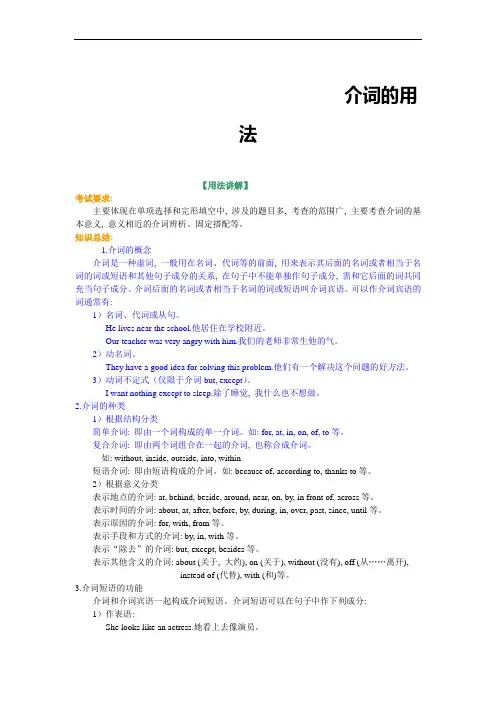
介词的用法【用法讲解】考试要求:主要体现在单项选择和完形填空中, 涉及的题目多, 考查的范围广, 主要考查介词的基本意义, 意义相近的介词辨析、固定搭配等。
知识总结:1.介词的概念介词是一种虚词, 一般用在名词、代词等的前面, 用来表示其后面的名词或者相当于名词的词或短语和其他句子成分的关系, 在句子中不能单独作句子成分, 需和它后面的词共同充当句子成分。
介词后面的名词或者相当于名词的词或短语叫介词宾语。
可以作介词宾语的词通常有:1)名词、代词或从句。
He lives near the school.他居住在学校附近。
Our teacher was very angry with him.我们的老师非常生他的气。
2)动名词。
They have a good idea for solving this problem.他们有一个解决这个问题的好方法。
3)动词不定式(仅限于介词but, except)。
I want nothing except to sleep.除了睡觉, 我什么也不想做。
2.介词的种类1)根据结构分类简单介词: 即由一个词构成的单一介词。
如: for, at, in, on, of, to等。
复合介词: 即由两个词组合在一起的介词, 也称合成介词。
如: without, inside, outside, into, within短语介词: 即由短语构成的介词。
如: because of, according to, thanks to等。
2)根据意义分类表示地点的介词: at, behind, beside, around, near, on, by, in front of, across等。
表示时间的介词: about, at, after, before, by, during, in, over, past, since, until等。
表示原因的介词: for, with, from等。

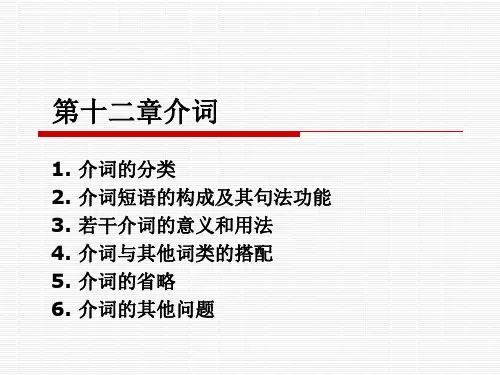
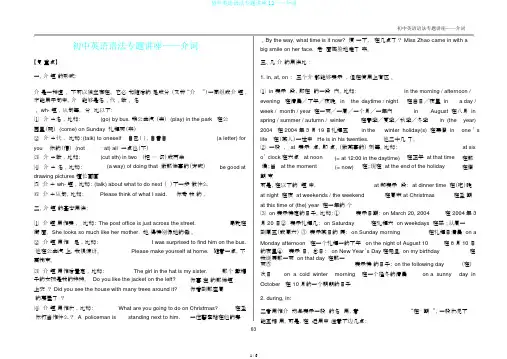
初中英语语法专题讲座——介词【复重点】一、介短的形式:介是一种虚,不可以独立存在。
它必和随后的足成分(又称“介”)一同组成介短,才能用于句中。
介能够是名、代、数、名、 wh- 短、从句等。
分比以下:⑴介+名,比如:(go) by bus 乘公共汽(去) (play) in the park 在公园里(玩) (come) on Sunday 礼拜天(来)⑵介+代,比如:(talk) to oneself 自己(),自言自(a letter) for you你的(信) (not⋯ at) all 一点也(不)⑶介+数,比如:(cut sth) in two (把⋯⋯切)成两半⑷介+名,比如:(a way) of doing that 做那件事的(方式)be good at drawing pictures 擅长画画⑸介+ wh- 短,比如: (talk) about what to do next ()下一步做什么⑹介+从句,比如:Please think of what I said.你考我的。
二、介短的基本用法:⑴介短用作表,比如: The post office is just across the street.局就在街面。
She looks so much like her mother. 她得特别像她的母。
⑵ 介短用作足,比如:I was surprised to find him on the bus.他在公共汽上,我很惊讶。
Please make yourself at home. 随意一点,不要拘束。
⑶ 介短用作后置定,比如:The girl in the hat is my sister.那个戴帽子的女孩是我的妹妹。
Do you like the jacket on the left?你喜左的那件短上衣? Did you see the house with many trees around it?你看到那座周的房屋了?⑷ 介短用作状,比如:What are you going to do on Christmas?在圣你打当作什么? A policeman is standing next to him.一位警察站在他的旁初中英语语法专题讲座——介词。
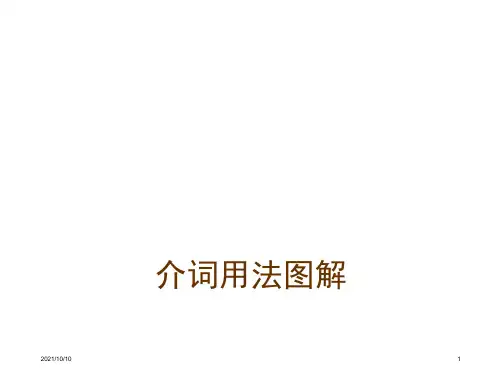



英语介词知识总结归纳英语介词知识总结归纳篇一介词又叫前置词,是一种虚词。
介词分为三种,一种是简单介词,如at, in, on, beside, to , for等;另一种是短语介词,即由两个以上的词组组成的短语,如in front of, because of, out of, instead of等;还有一种叫二重介词,如until after, from behind等。
(一)介词的句法功能介词不能独立在句中做成份,介词后必须与名词、代词、或动名词构成介词短语在句中充当一个成份,表示人、物、事件等与其它人、物、事件等之间的关系。
1、作定语:The book on the table is mine.2、作状语:We have breakfast at seven.(表时间);They were late for meeting because of the heavy rain.(表原因);They started the machine by pressing the button.(表方法)3、作表语:My dictionary is in the bag.4、作宾语补足语:I found him in the office.(二)主要介词区别1、表示时间的at, in, on:at表示片刻的时间,如:at 8 o’clock ,常用词组有:at noon, at night, at midnight, at the end of, at that time, at the beginning of, at the age of, at Christmas, at New Year等。
in表示一段的时间,如:in the morning, in the afternoon, in the evening, in October, in 1998, in summer, in the past, in the future等。
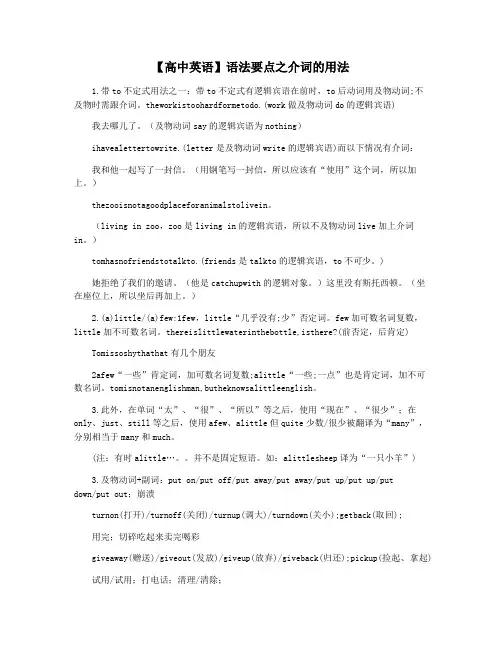
【高中英语】语法要点之介词的用法1.带to不定式用法之一:带to不定式有逻辑宾语在前时,to后动词用及物动词;不及物时需跟介词。
theworkistoohardformetodo.(work做及物动词do的逻辑宾语)我去哪儿了。
(及物动词say的逻辑宾语为nothing)ihavealettertowrite.(letter是及物动词write的逻辑宾语)而以下情况有介词:我和他一起写了一封信。
(用钢笔写一封信,所以应该有“使用”这个词,所以加上。
)thezooisnotagoodplaceforanimalstolivein。
(living in zoo,zoo是living in的逻辑宾语,所以不及物动词live加上介词in。
)tomhasnofriendstotalkto.(friends是talkto的逻辑宾语,to不可少。
)她拒绝了我们的邀请。
(他是catchupwith的逻辑对象。
)这里没有斯托西顿。
(坐在座位上,所以坐后再加上。
)2.(a)little/(a)few:1few,little“几乎没有;少”否定词。
few加可数名词复数,little加不可数名词。
thereislittlewaterinthebottle,isthere?(前否定,后肯定)Tomissoshythathat有几个朋友2afew“一些”肯定词,加可数名词复数;alittle“一些;一点”也是肯定词,加不可数名词。
tomisnotanenglishman,butheknowsalittleenglish。
3.此外,在单词“太”、“很”、“所以”等之后,使用“现在”、“很少”;在only、just、still等之后,使用afew、alittle但quite少数/很少被翻译为“many”,分别相当于many和much。
(注:有时alittle…。
并不是固定短语。
如:alittlesheep译为“一只小羊”)3.及物动词+副词:put on/put off/put away/put away/put up/put up/putdown/put out;崩溃turnon(打开)/turnoff(关闭)/turnup(调大)/turndown(关小);getback(取回);用完;切碎吃起来卖完喝彩giveaway(赠送)/giveout(发放)/giveup(放弃)/giveback(归还);pickup(捡起、拿起)试用/试用;打电话;清理/清除;setup(成立);thinkup(想出;想起);handin(上交)/handout(分发;散发);修理;锻炼和打扮;帮助摆脱困境keepoff/keepout(阻止;挡住);takeoff(脱下)/takeaway(拿走)/takeout(拿出);查找/查找;扔掉/停止唤醒;减记(减记);失望;弥补;抵消(触发)注:名词做以上短语的宾语,可放在它们中间或后边;而代词做宾语,只放在中间。
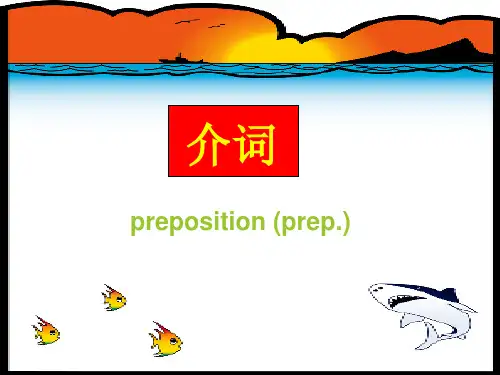
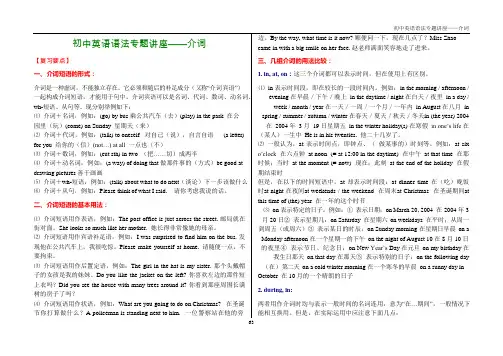
【复习要点】初中英语语法专题讲座——介词边。
By the way, what time is it now? 顺便问一下,现在几点了?Miss Zhaocame in with a big smile on her face. 赵老师满面笑容地走了进来。
三、几组介词的用法比较:一、介词短语的形式:介词是一种虚词,不能独立存在。
它必须和随后的补足成分(又称“介词宾语”)一起构成介词短语,才能用于句中。
介词宾语可以是名词、代词、数词、动名词、wh-短语、从句等。
现分别举例如下:⑴介词+名词,例如:(go) by bus 乘公共汽车(去)(play) in the park 在公园里(玩)(come) on Sunday 星期天(来)⑵介词+代词,例如:(talk) to oneself 对自己(说),自言自语(a letter) for you 给你的(信)(not…) at all 一点也(不)⑶介词+数词,例如:(cut sth) in two (把……切)成两半⑷介词+动名词,例如:(a way) of doing that 做那件事的(方式)be good at drawing pictures 善于画画⑸介词+wh-短语,例如:(talk) about what to do next(谈论)下一步该做什么⑹介词+从句,例如:Please think of what I said. 请你考虑我说的话。
二、介词短语的基本用法:⑴介词短语用作表语,例如:The post office is just across the street. 邮局就在街对面。
She looks so much like her mother. 她长得非常像她的母亲。
⑵介词短语用作宾语补足语,例如:I was surprised to find him on the bus. 发现他在公共汽车上,我很吃惊。
Please make yourself at home. 请随便一点,不要拘束。
名词性从句【知识精讲】在句子中起名词作用的句子叫名词性从句。
名词性从句的功能相当于名词词组, 它在复合句中能担任主语、宾语、表语、同位语、介词宾语等,因此根据它在句中不同的语法功能,名词从句又可分别称为主语从句、宾语从句、表语从句和同位语从句。
一、引导名词性从句的连接词(一)引导名词性从句的连接词可分为三类:1.连词:that(无任何词意,陈述句充当名词性从句)whether ,if(均表示“是否”表明从句内容的不确定性,一般疑问句充当名词性从句)as if ,as though(均表示“好像”,“似乎”)以上在从句中均不充当任何成分2.连接代词:what, whatever, who, whoever, whom,whose, which. whichever, whomever3.连接副词:when, where, how, why(由特殊疑问句充当名词性从句)(二)、名词性that-从句1.由从属连词that引导的从句叫做名词性that-从句。
That只起连接主句和从句的作用,在从句中不担任任何成分,本身也没有词义。
名词性that-从句在句中能充当主语、宾语、表语、同位语和形容词宾语,例如:主语:That he is still alive is sheer luck.宾语:John said that he was leaving for London on Wednesday.表语:The fact is that he has not been seen recently.同位语:The fact that he has not been seen recently disturbs everyone in his office.形容词宾语:I am glad that you are satisfied with your job.2.That-从句作主语通常用it作先行词,而将that-从句置于句末,例如:●It is quite clear that the whole project is doomed to failure.●It's a pity that you should have to leave.(三)名词性wh-从句1.由wh-词引导的名词从句叫做名词性wh-从句。
介词(preposition简写prep.)又称作前置词,表示名词、代词等与句中其他词的关系,在句中不能单独作句子成分。
介词后面一般有名词、代词或相当于名词的其他词类、短语或从句作它的宾语,表示与其他成分的关系。
介词和它的宾语构成介词词组,在句中作状语,表语,补语,定语或介词宾语。
介词可以分为时间介词、地点介词、方式介词、原因介词、数量介词和其他介词。
介词一般用于名词或者代词前面,表示该词与句中其他成分的关系。
介词后面的名词或代词称为介词宾语(如果是人称代词,则要用宾格)。
介词和介词宾语合在一起构成介词短语。
1、介词分类............................................P3(1)按构成分类........................................P3(2)按用途分类........................................P32、主要用途............................................P4(1)表示时间..........................................P4(2)表示方位..........................................P5(3)表示原因..........................................P7(4)表示方法..........................................P7(5)表示进行..........................................P7(6)表示数量..........................................P73、与不及物动词搭配....................................P74、常用介词短语........................................P7(1)按构成分类①简单介词in,on,with,by,for,at,about,under,of等。
(完整word版)介词的用法总结(word版可编辑修改)编辑整理:尊敬的读者朋友们:这里是精品文档编辑中心,本文档内容是由我和我的同事精心编辑整理后发布的,发布之前我们对文中内容进行仔细校对,但是难免会有疏漏的地方,但是任然希望((完整word版)介词的用法总结(word版可编辑修改))的内容能够给您的工作和学习带来便利。
同时也真诚的希望收到您的建议和反馈,这将是我们进步的源泉,前进的动力。
本文可编辑可修改,如果觉得对您有帮助请收藏以便随时查阅,最后祝您生活愉快业绩进步,以下为(完整word版)介词的用法总结(word版可编辑修改)的全部内容。
介词的用法1。
表示地点位置的介词1)at ,in, on, to,forat (1)表示在小地方;(2)表示“在……附近,旁边”in (1)表示在大地方; (2)表示“在…范围之内”。
on 表示毗邻,接壤,“在……上面”.to 表示在……范围外,不强调是否接壤;或“到……”2)above, over, on 在……上above 指在……上方,不强调是否垂直,与 below相对;over指垂直的上方,与under相对,但over与物体有一定的空间,不直接接触。
on表示某物体上面并与之接触。
The bird is flying above my head. There is a bridge over the river。
He put his watch on the desk.3)below, under 在……下面under表示在…正下方below表示在……下,不一定在正下方There is a cat under the table。
Please write your name below the line。
4)in front [frant]of, in the front of在……前面in front of…意思是“在……前面",指甲物在乙物之前,两者互不包括;其反义词是behind(在……的后面)。